ECO10001 Portfolio: Analyzing Poverty and Solutions in Australia
VerifiedAdded on 2023/06/07
|7
|1791
|331
Essay
AI Summary
This essay examines the issue of poverty in Australia, despite its status as a wealthy and developed nation. It highlights unique characteristics of poverty in the country, including the disproportionate impact on indigenous and elderly populations, and the rising poverty rates among children and youth. The essay discusses the role of economic inequality in exacerbating poverty levels. It proposes several intervention strategies for the Australian government, including creating employment opportunities through strategic economic development like establishing local oil refineries, providing microfinancing to support entrepreneurial endeavors among low-income citizens, raising the minimum wage to ensure a living wage, establishing effective work schedules through a 24/7 economy model, encouraging agricultural programs with support for farmers, and promoting both local and external trade to provide market access for poverty-stricken producers. The essay concludes that these approaches, inspired by successful strategies in countries with low poverty rates, can significantly reduce poverty in Australia.
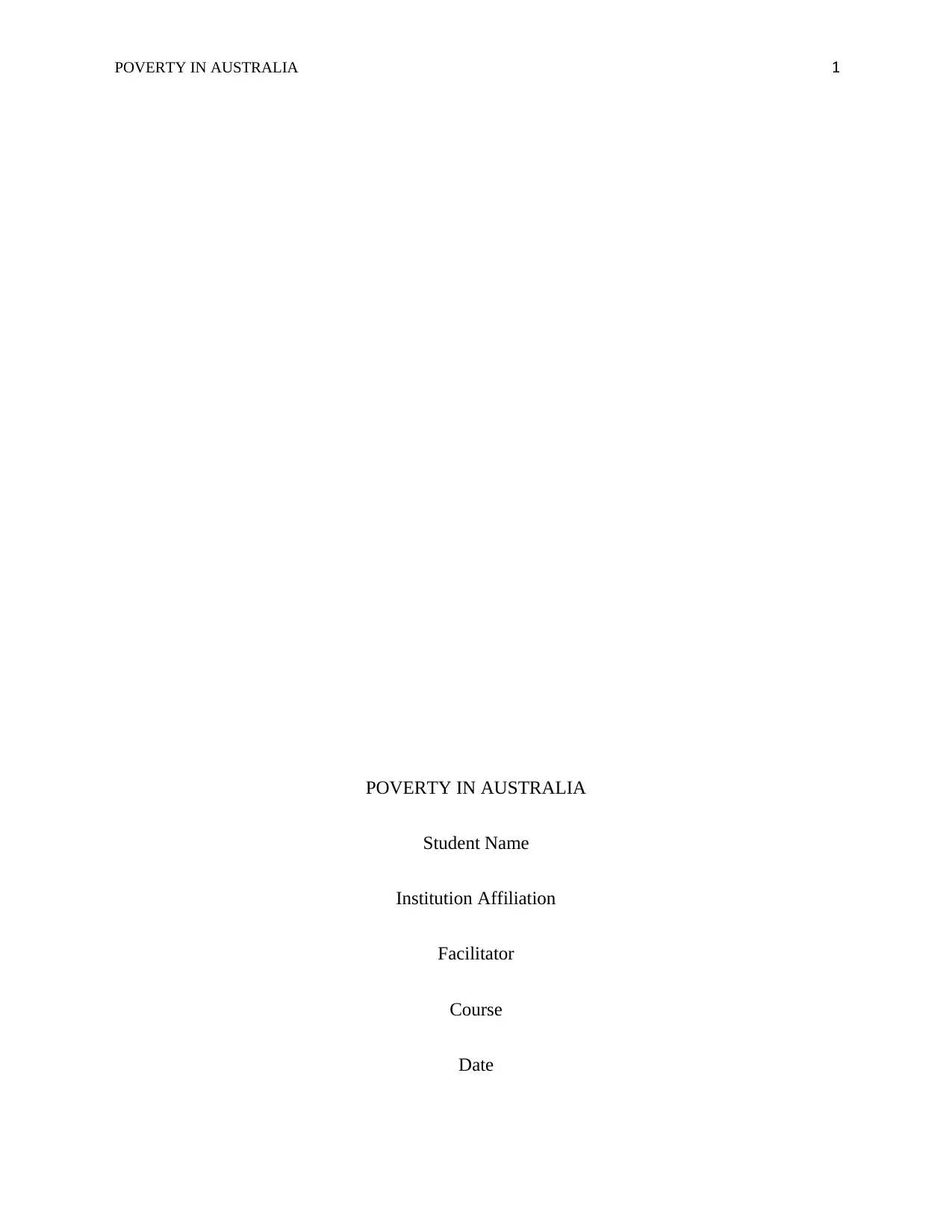
POVERTY IN AUSTRALIA 1
POVERTY IN AUSTRALIA
Student Name
Institution Affiliation
Facilitator
Course
Date
POVERTY IN AUSTRALIA
Student Name
Institution Affiliation
Facilitator
Course
Date
Paraphrase This Document
Need a fresh take? Get an instant paraphrase of this document with our AI Paraphraser
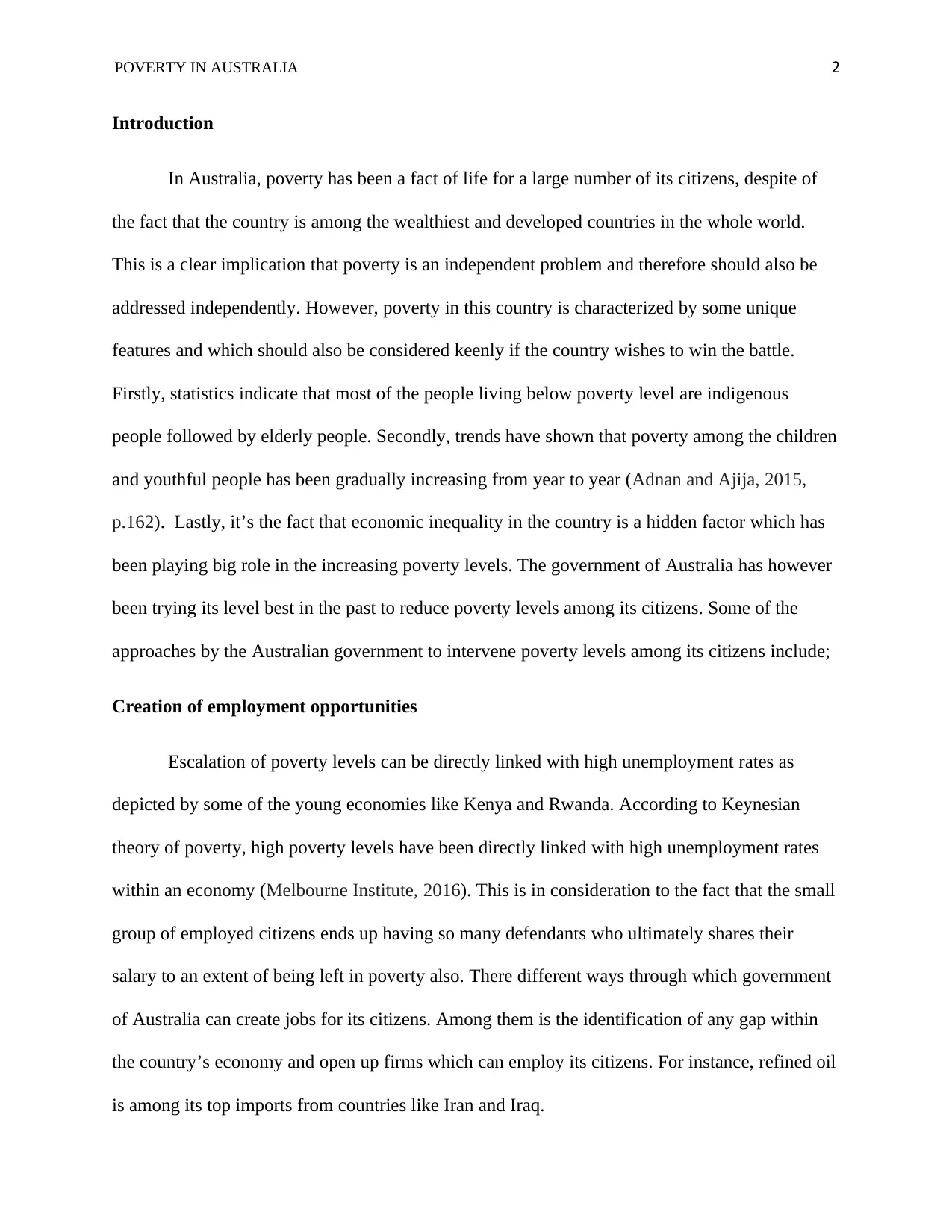
POVERTY IN AUSTRALIA 2
Introduction
In Australia, poverty has been a fact of life for a large number of its citizens, despite of
the fact that the country is among the wealthiest and developed countries in the whole world.
This is a clear implication that poverty is an independent problem and therefore should also be
addressed independently. However, poverty in this country is characterized by some unique
features and which should also be considered keenly if the country wishes to win the battle.
Firstly, statistics indicate that most of the people living below poverty level are indigenous
people followed by elderly people. Secondly, trends have shown that poverty among the children
and youthful people has been gradually increasing from year to year (Adnan and Ajija, 2015,
p.162). Lastly, it’s the fact that economic inequality in the country is a hidden factor which has
been playing big role in the increasing poverty levels. The government of Australia has however
been trying its level best in the past to reduce poverty levels among its citizens. Some of the
approaches by the Australian government to intervene poverty levels among its citizens include;
Creation of employment opportunities
Escalation of poverty levels can be directly linked with high unemployment rates as
depicted by some of the young economies like Kenya and Rwanda. According to Keynesian
theory of poverty, high poverty levels have been directly linked with high unemployment rates
within an economy (Melbourne Institute, 2016). This is in consideration to the fact that the small
group of employed citizens ends up having so many defendants who ultimately shares their
salary to an extent of being left in poverty also. There different ways through which government
of Australia can create jobs for its citizens. Among them is the identification of any gap within
the country’s economy and open up firms which can employ its citizens. For instance, refined oil
is among its top imports from countries like Iran and Iraq.
Introduction
In Australia, poverty has been a fact of life for a large number of its citizens, despite of
the fact that the country is among the wealthiest and developed countries in the whole world.
This is a clear implication that poverty is an independent problem and therefore should also be
addressed independently. However, poverty in this country is characterized by some unique
features and which should also be considered keenly if the country wishes to win the battle.
Firstly, statistics indicate that most of the people living below poverty level are indigenous
people followed by elderly people. Secondly, trends have shown that poverty among the children
and youthful people has been gradually increasing from year to year (Adnan and Ajija, 2015,
p.162). Lastly, it’s the fact that economic inequality in the country is a hidden factor which has
been playing big role in the increasing poverty levels. The government of Australia has however
been trying its level best in the past to reduce poverty levels among its citizens. Some of the
approaches by the Australian government to intervene poverty levels among its citizens include;
Creation of employment opportunities
Escalation of poverty levels can be directly linked with high unemployment rates as
depicted by some of the young economies like Kenya and Rwanda. According to Keynesian
theory of poverty, high poverty levels have been directly linked with high unemployment rates
within an economy (Melbourne Institute, 2016). This is in consideration to the fact that the small
group of employed citizens ends up having so many defendants who ultimately shares their
salary to an extent of being left in poverty also. There different ways through which government
of Australia can create jobs for its citizens. Among them is the identification of any gap within
the country’s economy and open up firms which can employ its citizens. For instance, refined oil
is among its top imports from countries like Iran and Iraq.
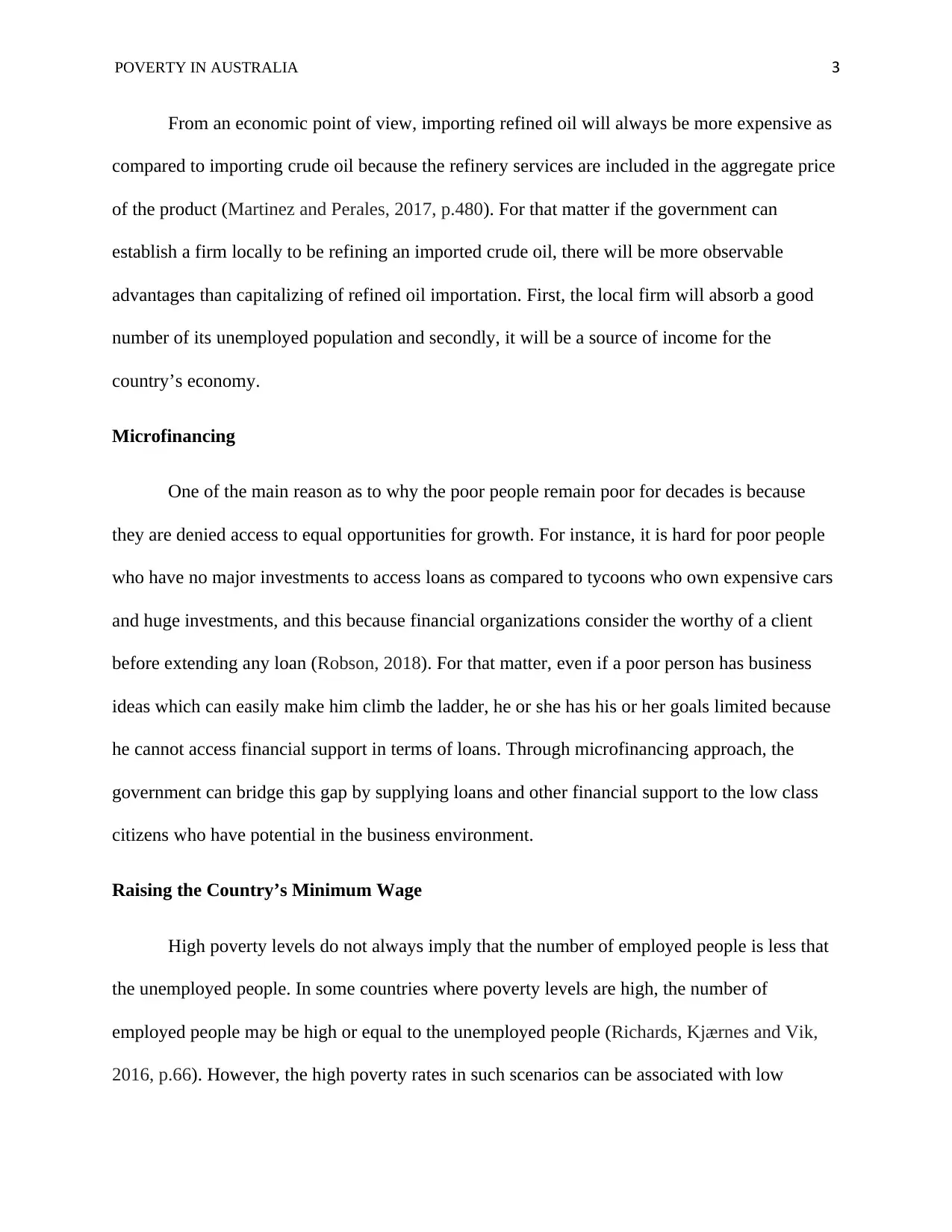
POVERTY IN AUSTRALIA 3
From an economic point of view, importing refined oil will always be more expensive as
compared to importing crude oil because the refinery services are included in the aggregate price
of the product (Martinez and Perales, 2017, p.480). For that matter if the government can
establish a firm locally to be refining an imported crude oil, there will be more observable
advantages than capitalizing of refined oil importation. First, the local firm will absorb a good
number of its unemployed population and secondly, it will be a source of income for the
country’s economy.
Microfinancing
One of the main reason as to why the poor people remain poor for decades is because
they are denied access to equal opportunities for growth. For instance, it is hard for poor people
who have no major investments to access loans as compared to tycoons who own expensive cars
and huge investments, and this because financial organizations consider the worthy of a client
before extending any loan (Robson, 2018). For that matter, even if a poor person has business
ideas which can easily make him climb the ladder, he or she has his or her goals limited because
he cannot access financial support in terms of loans. Through microfinancing approach, the
government can bridge this gap by supplying loans and other financial support to the low class
citizens who have potential in the business environment.
Raising the Country’s Minimum Wage
High poverty levels do not always imply that the number of employed people is less that
the unemployed people. In some countries where poverty levels are high, the number of
employed people may be high or equal to the unemployed people (Richards, Kjærnes and Vik,
2016, p.66). However, the high poverty rates in such scenarios can be associated with low
From an economic point of view, importing refined oil will always be more expensive as
compared to importing crude oil because the refinery services are included in the aggregate price
of the product (Martinez and Perales, 2017, p.480). For that matter if the government can
establish a firm locally to be refining an imported crude oil, there will be more observable
advantages than capitalizing of refined oil importation. First, the local firm will absorb a good
number of its unemployed population and secondly, it will be a source of income for the
country’s economy.
Microfinancing
One of the main reason as to why the poor people remain poor for decades is because
they are denied access to equal opportunities for growth. For instance, it is hard for poor people
who have no major investments to access loans as compared to tycoons who own expensive cars
and huge investments, and this because financial organizations consider the worthy of a client
before extending any loan (Robson, 2018). For that matter, even if a poor person has business
ideas which can easily make him climb the ladder, he or she has his or her goals limited because
he cannot access financial support in terms of loans. Through microfinancing approach, the
government can bridge this gap by supplying loans and other financial support to the low class
citizens who have potential in the business environment.
Raising the Country’s Minimum Wage
High poverty levels do not always imply that the number of employed people is less that
the unemployed people. In some countries where poverty levels are high, the number of
employed people may be high or equal to the unemployed people (Richards, Kjærnes and Vik,
2016, p.66). However, the high poverty rates in such scenarios can be associated with low
⊘ This is a preview!⊘
Do you want full access?
Subscribe today to unlock all pages.

Trusted by 1+ million students worldwide
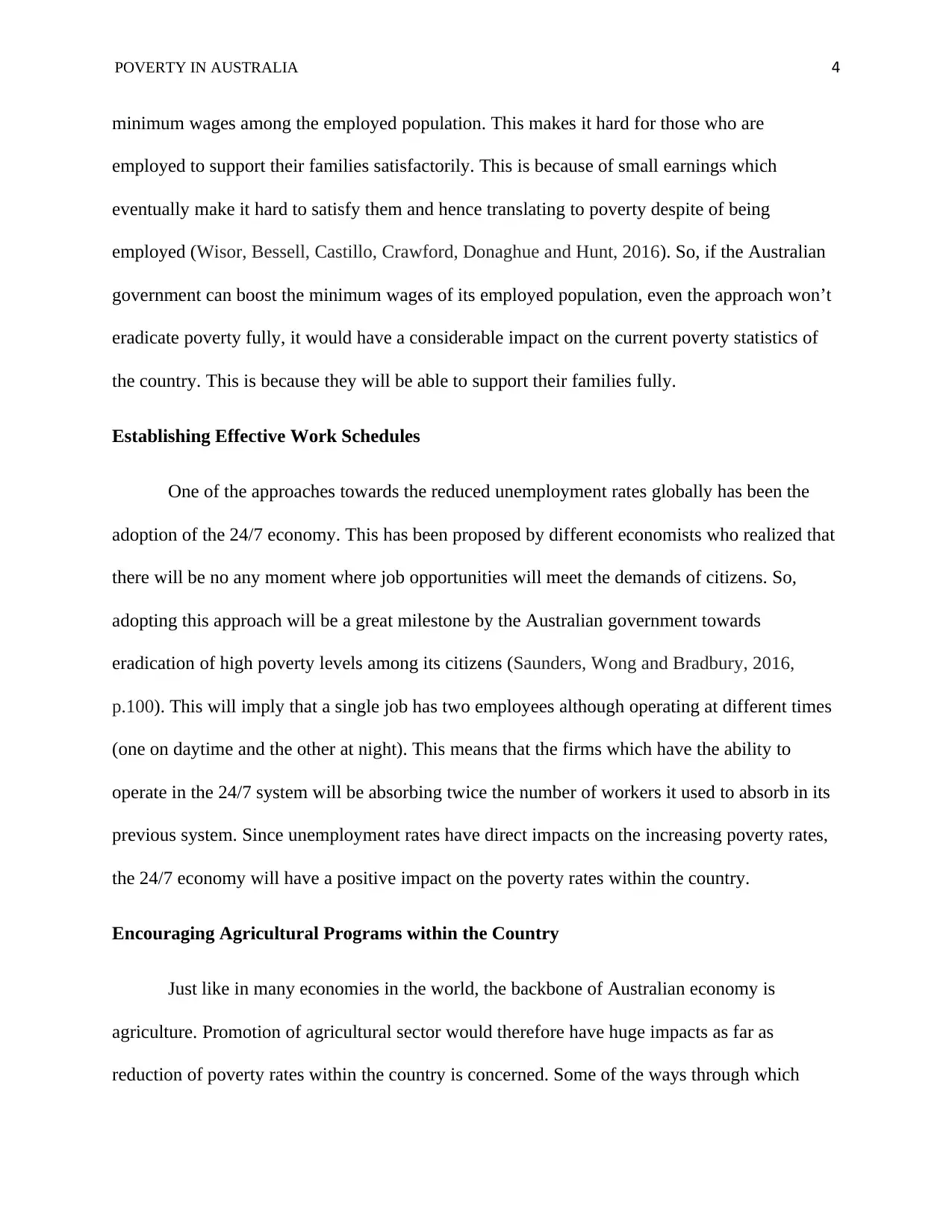
POVERTY IN AUSTRALIA 4
minimum wages among the employed population. This makes it hard for those who are
employed to support their families satisfactorily. This is because of small earnings which
eventually make it hard to satisfy them and hence translating to poverty despite of being
employed (Wisor, Bessell, Castillo, Crawford, Donaghue and Hunt, 2016). So, if the Australian
government can boost the minimum wages of its employed population, even the approach won’t
eradicate poverty fully, it would have a considerable impact on the current poverty statistics of
the country. This is because they will be able to support their families fully.
Establishing Effective Work Schedules
One of the approaches towards the reduced unemployment rates globally has been the
adoption of the 24/7 economy. This has been proposed by different economists who realized that
there will be no any moment where job opportunities will meet the demands of citizens. So,
adopting this approach will be a great milestone by the Australian government towards
eradication of high poverty levels among its citizens (Saunders, Wong and Bradbury, 2016,
p.100). This will imply that a single job has two employees although operating at different times
(one on daytime and the other at night). This means that the firms which have the ability to
operate in the 24/7 system will be absorbing twice the number of workers it used to absorb in its
previous system. Since unemployment rates have direct impacts on the increasing poverty rates,
the 24/7 economy will have a positive impact on the poverty rates within the country.
Encouraging Agricultural Programs within the Country
Just like in many economies in the world, the backbone of Australian economy is
agriculture. Promotion of agricultural sector would therefore have huge impacts as far as
reduction of poverty rates within the country is concerned. Some of the ways through which
minimum wages among the employed population. This makes it hard for those who are
employed to support their families satisfactorily. This is because of small earnings which
eventually make it hard to satisfy them and hence translating to poverty despite of being
employed (Wisor, Bessell, Castillo, Crawford, Donaghue and Hunt, 2016). So, if the Australian
government can boost the minimum wages of its employed population, even the approach won’t
eradicate poverty fully, it would have a considerable impact on the current poverty statistics of
the country. This is because they will be able to support their families fully.
Establishing Effective Work Schedules
One of the approaches towards the reduced unemployment rates globally has been the
adoption of the 24/7 economy. This has been proposed by different economists who realized that
there will be no any moment where job opportunities will meet the demands of citizens. So,
adopting this approach will be a great milestone by the Australian government towards
eradication of high poverty levels among its citizens (Saunders, Wong and Bradbury, 2016,
p.100). This will imply that a single job has two employees although operating at different times
(one on daytime and the other at night). This means that the firms which have the ability to
operate in the 24/7 system will be absorbing twice the number of workers it used to absorb in its
previous system. Since unemployment rates have direct impacts on the increasing poverty rates,
the 24/7 economy will have a positive impact on the poverty rates within the country.
Encouraging Agricultural Programs within the Country
Just like in many economies in the world, the backbone of Australian economy is
agriculture. Promotion of agricultural sector would therefore have huge impacts as far as
reduction of poverty rates within the country is concerned. Some of the ways through which
Paraphrase This Document
Need a fresh take? Get an instant paraphrase of this document with our AI Paraphraser
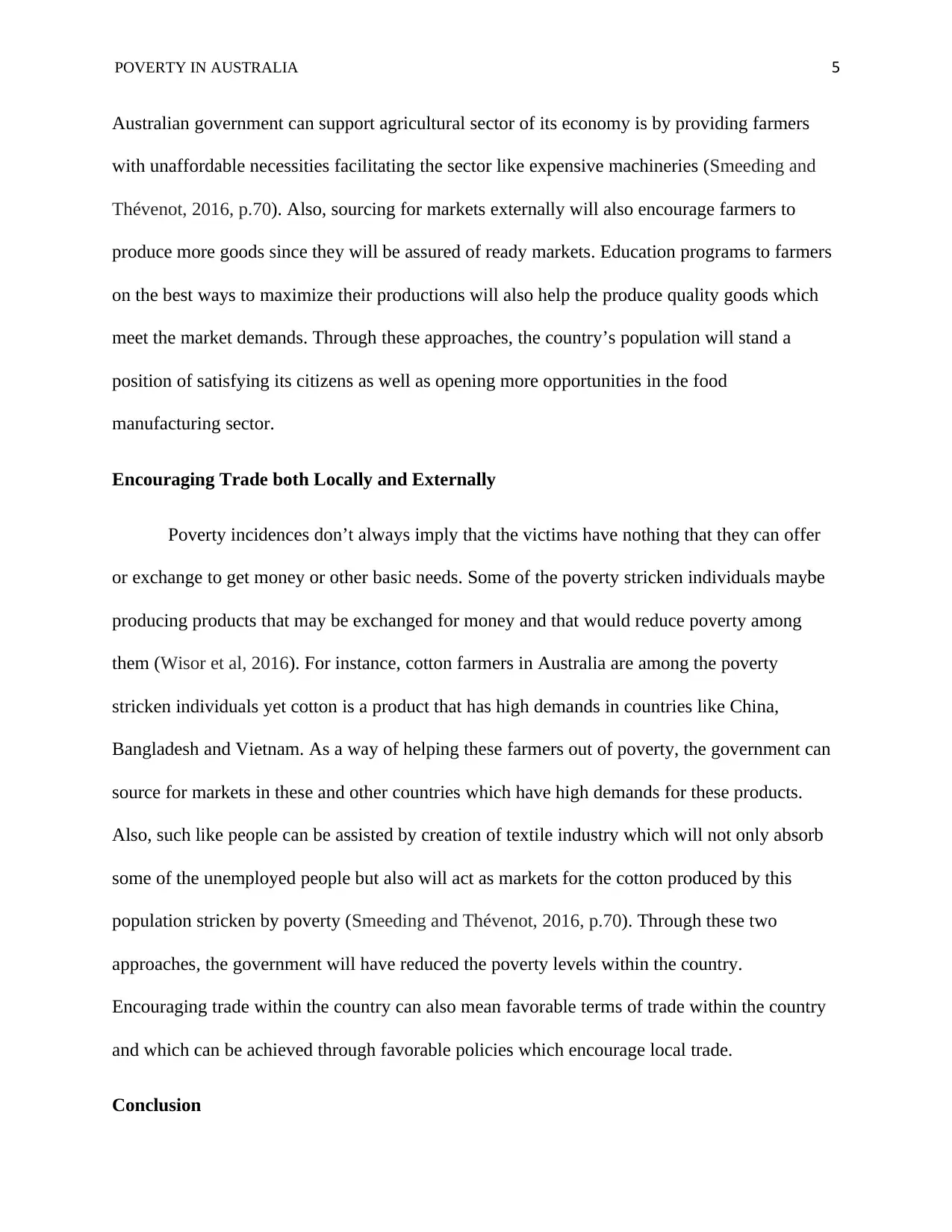
POVERTY IN AUSTRALIA 5
Australian government can support agricultural sector of its economy is by providing farmers
with unaffordable necessities facilitating the sector like expensive machineries (Smeeding and
Thévenot, 2016, p.70). Also, sourcing for markets externally will also encourage farmers to
produce more goods since they will be assured of ready markets. Education programs to farmers
on the best ways to maximize their productions will also help the produce quality goods which
meet the market demands. Through these approaches, the country’s population will stand a
position of satisfying its citizens as well as opening more opportunities in the food
manufacturing sector.
Encouraging Trade both Locally and Externally
Poverty incidences don’t always imply that the victims have nothing that they can offer
or exchange to get money or other basic needs. Some of the poverty stricken individuals maybe
producing products that may be exchanged for money and that would reduce poverty among
them (Wisor et al, 2016). For instance, cotton farmers in Australia are among the poverty
stricken individuals yet cotton is a product that has high demands in countries like China,
Bangladesh and Vietnam. As a way of helping these farmers out of poverty, the government can
source for markets in these and other countries which have high demands for these products.
Also, such like people can be assisted by creation of textile industry which will not only absorb
some of the unemployed people but also will act as markets for the cotton produced by this
population stricken by poverty (Smeeding and Thévenot, 2016, p.70). Through these two
approaches, the government will have reduced the poverty levels within the country.
Encouraging trade within the country can also mean favorable terms of trade within the country
and which can be achieved through favorable policies which encourage local trade.
Conclusion
Australian government can support agricultural sector of its economy is by providing farmers
with unaffordable necessities facilitating the sector like expensive machineries (Smeeding and
Thévenot, 2016, p.70). Also, sourcing for markets externally will also encourage farmers to
produce more goods since they will be assured of ready markets. Education programs to farmers
on the best ways to maximize their productions will also help the produce quality goods which
meet the market demands. Through these approaches, the country’s population will stand a
position of satisfying its citizens as well as opening more opportunities in the food
manufacturing sector.
Encouraging Trade both Locally and Externally
Poverty incidences don’t always imply that the victims have nothing that they can offer
or exchange to get money or other basic needs. Some of the poverty stricken individuals maybe
producing products that may be exchanged for money and that would reduce poverty among
them (Wisor et al, 2016). For instance, cotton farmers in Australia are among the poverty
stricken individuals yet cotton is a product that has high demands in countries like China,
Bangladesh and Vietnam. As a way of helping these farmers out of poverty, the government can
source for markets in these and other countries which have high demands for these products.
Also, such like people can be assisted by creation of textile industry which will not only absorb
some of the unemployed people but also will act as markets for the cotton produced by this
population stricken by poverty (Smeeding and Thévenot, 2016, p.70). Through these two
approaches, the government will have reduced the poverty levels within the country.
Encouraging trade within the country can also mean favorable terms of trade within the country
and which can be achieved through favorable policies which encourage local trade.
Conclusion
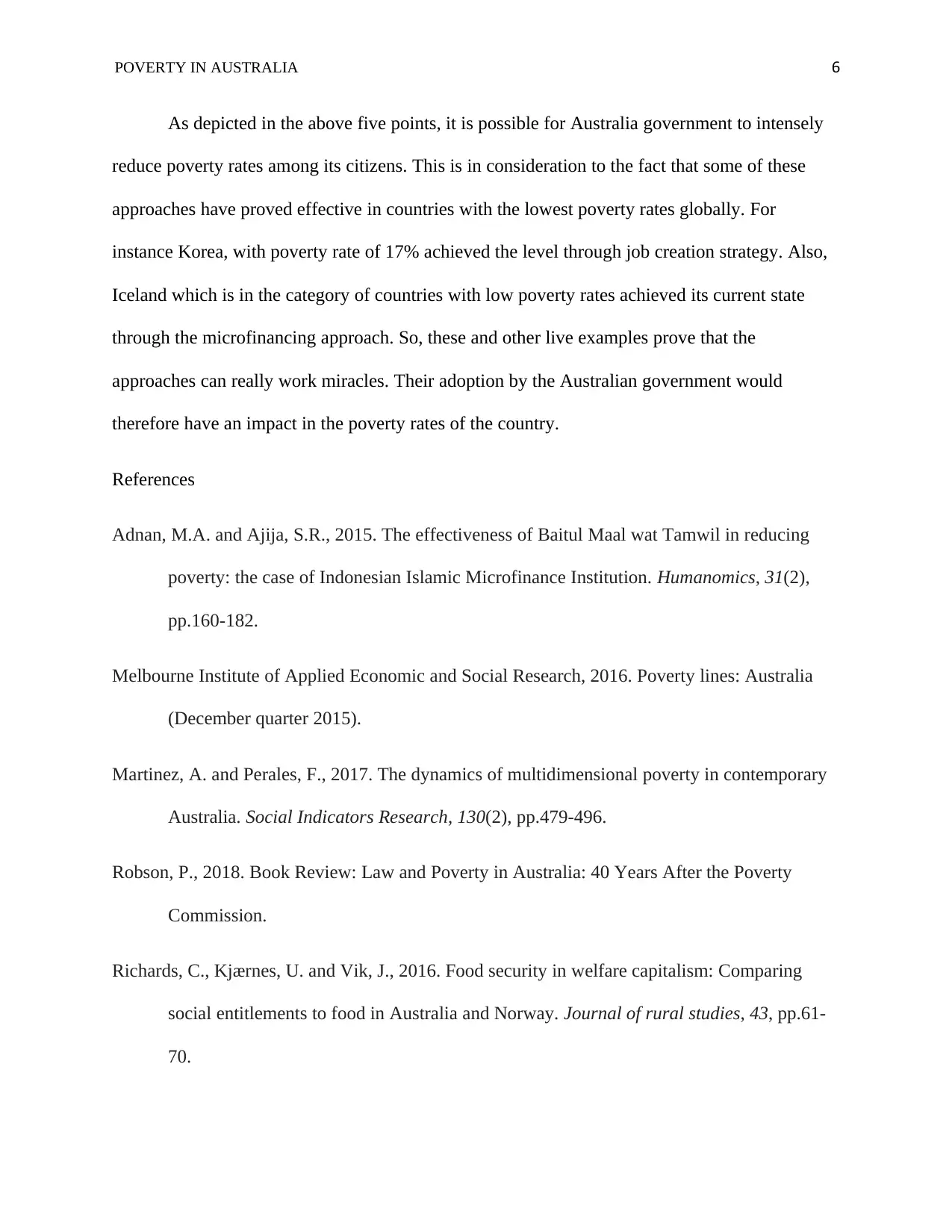
POVERTY IN AUSTRALIA 6
As depicted in the above five points, it is possible for Australia government to intensely
reduce poverty rates among its citizens. This is in consideration to the fact that some of these
approaches have proved effective in countries with the lowest poverty rates globally. For
instance Korea, with poverty rate of 17% achieved the level through job creation strategy. Also,
Iceland which is in the category of countries with low poverty rates achieved its current state
through the microfinancing approach. So, these and other live examples prove that the
approaches can really work miracles. Their adoption by the Australian government would
therefore have an impact in the poverty rates of the country.
References
Adnan, M.A. and Ajija, S.R., 2015. The effectiveness of Baitul Maal wat Tamwil in reducing
poverty: the case of Indonesian Islamic Microfinance Institution. Humanomics, 31(2),
pp.160-182.
Melbourne Institute of Applied Economic and Social Research, 2016. Poverty lines: Australia
(December quarter 2015).
Martinez, A. and Perales, F., 2017. The dynamics of multidimensional poverty in contemporary
Australia. Social Indicators Research, 130(2), pp.479-496.
Robson, P., 2018. Book Review: Law and Poverty in Australia: 40 Years After the Poverty
Commission.
Richards, C., Kjærnes, U. and Vik, J., 2016. Food security in welfare capitalism: Comparing
social entitlements to food in Australia and Norway. Journal of rural studies, 43, pp.61-
70.
As depicted in the above five points, it is possible for Australia government to intensely
reduce poverty rates among its citizens. This is in consideration to the fact that some of these
approaches have proved effective in countries with the lowest poverty rates globally. For
instance Korea, with poverty rate of 17% achieved the level through job creation strategy. Also,
Iceland which is in the category of countries with low poverty rates achieved its current state
through the microfinancing approach. So, these and other live examples prove that the
approaches can really work miracles. Their adoption by the Australian government would
therefore have an impact in the poverty rates of the country.
References
Adnan, M.A. and Ajija, S.R., 2015. The effectiveness of Baitul Maal wat Tamwil in reducing
poverty: the case of Indonesian Islamic Microfinance Institution. Humanomics, 31(2),
pp.160-182.
Melbourne Institute of Applied Economic and Social Research, 2016. Poverty lines: Australia
(December quarter 2015).
Martinez, A. and Perales, F., 2017. The dynamics of multidimensional poverty in contemporary
Australia. Social Indicators Research, 130(2), pp.479-496.
Robson, P., 2018. Book Review: Law and Poverty in Australia: 40 Years After the Poverty
Commission.
Richards, C., Kjærnes, U. and Vik, J., 2016. Food security in welfare capitalism: Comparing
social entitlements to food in Australia and Norway. Journal of rural studies, 43, pp.61-
70.
⊘ This is a preview!⊘
Do you want full access?
Subscribe today to unlock all pages.

Trusted by 1+ million students worldwide
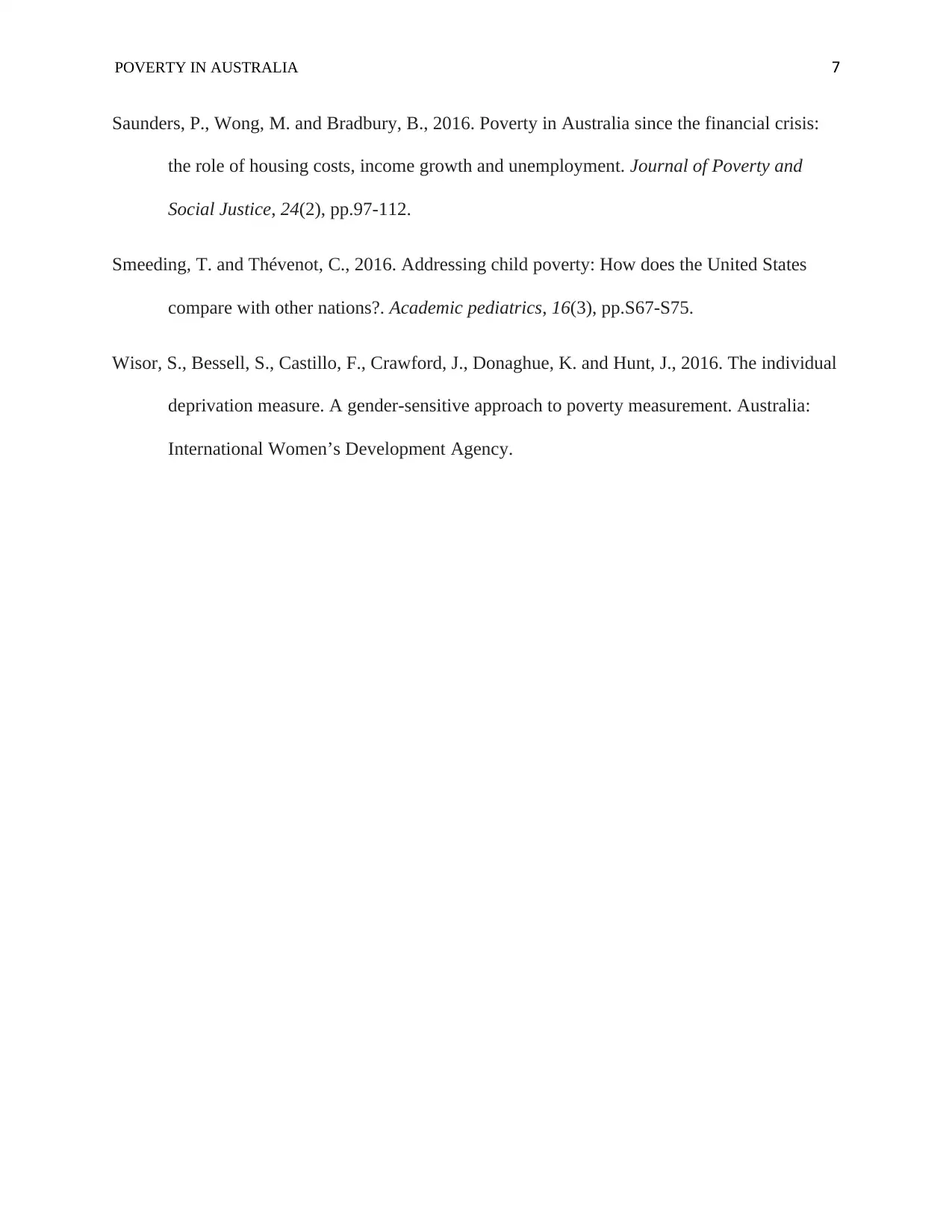
POVERTY IN AUSTRALIA 7
Saunders, P., Wong, M. and Bradbury, B., 2016. Poverty in Australia since the financial crisis:
the role of housing costs, income growth and unemployment. Journal of Poverty and
Social Justice, 24(2), pp.97-112.
Smeeding, T. and Thévenot, C., 2016. Addressing child poverty: How does the United States
compare with other nations?. Academic pediatrics, 16(3), pp.S67-S75.
Wisor, S., Bessell, S., Castillo, F., Crawford, J., Donaghue, K. and Hunt, J., 2016. The individual
deprivation measure. A gender-sensitive approach to poverty measurement. Australia:
International Women’s Development Agency.
Saunders, P., Wong, M. and Bradbury, B., 2016. Poverty in Australia since the financial crisis:
the role of housing costs, income growth and unemployment. Journal of Poverty and
Social Justice, 24(2), pp.97-112.
Smeeding, T. and Thévenot, C., 2016. Addressing child poverty: How does the United States
compare with other nations?. Academic pediatrics, 16(3), pp.S67-S75.
Wisor, S., Bessell, S., Castillo, F., Crawford, J., Donaghue, K. and Hunt, J., 2016. The individual
deprivation measure. A gender-sensitive approach to poverty measurement. Australia:
International Women’s Development Agency.
1 out of 7
Related Documents
Your All-in-One AI-Powered Toolkit for Academic Success.
+13062052269
info@desklib.com
Available 24*7 on WhatsApp / Email
![[object Object]](/_next/static/media/star-bottom.7253800d.svg)
Unlock your academic potential
Copyright © 2020–2025 A2Z Services. All Rights Reserved. Developed and managed by ZUCOL.





